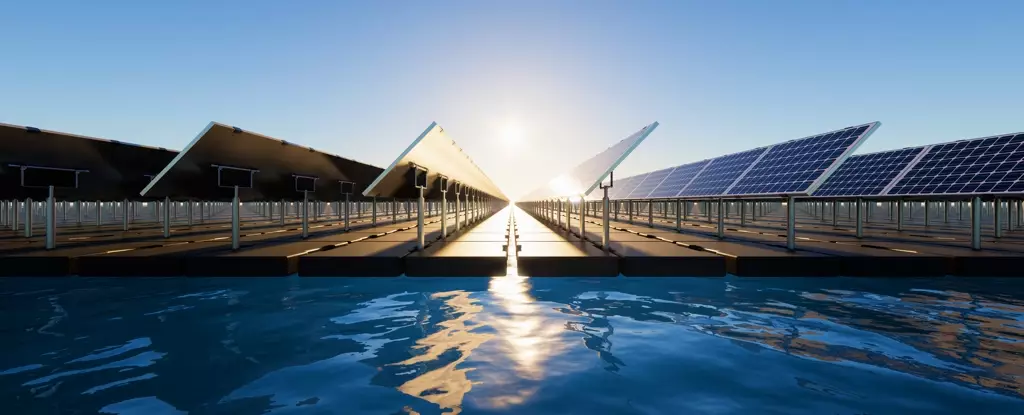The rapid transition to renewable energy sources is essential for combating climate change and creating a sustainable future. Solar and wind energy are two of the most promising alternatives to fossil fuels, but countries with high population densities face challenges in finding enough space for solar energy harvesting. However, a groundbreaking new study suggests that offshore floating solar panels could be the solution for densely populated regions like Southeast Asia and West Africa. By harnessing the abundant solar resources of calm equatorial seas, these countries could potentially generate vast amounts of solar energy. This article explores the implications of this research and the potential benefits of offshore floating solar panels in these regions.
The Promise of Offshore Floating Solar Panels
Traditional solar panels require large land areas for installation, making it difficult for countries with limited space to adopt solar energy on a large scale. However, offshore floating solar panels offer a unique opportunity to overcome this challenge. The study reveals that Indonesia alone could generate approximately 35,000 terawatt-hours (TWh) of solar energy per year, which is equivalent to the current global electricity production of 30,000 TWh. This indicates that offshore solar in Southeast Asia and West Africa has the potential to provide effectively unlimited solar energy to densely populated countries in these regions.
Opportunities in Southeast Asia and West Africa
The research identifies Indonesia and equatorial West Africa, particularly near Nigeria, as areas with the greatest potential for offshore floating solar arrays. These regions experience relatively calm and peaceful conditions, making it feasible to deploy solar panels on the open seas. Additionally, these areas are characterized by high population growth and valuable intact ecosystems, making it crucial to find sustainable solutions that do not require clearing land for solar farms.
The Benefits of Offshore Floating Solar
Floating solar panels offer several advantages over traditional solar installations. They can be placed on inland lakes, reservoirs, or bodies of water near the coast, reducing the competition for limited land space. Inland floating solar has already demonstrated its potential and is growing rapidly. Moreover, offshore installations benefit from the ability to capture more sunlight due to the absence of shading from surrounding structures and vegetation. This leads to increased energy production and efficiency.
Sustainable Energy Solutions for Densely Populated Regions
Countries with high population densities, such as Indonesia and Nigeria, face unique challenges in meeting their energy requirements sustainably. These nations are located in the so-called “doldrum” latitudes, where wind resources are insufficient for wind energy generation. However, the abundance of solar energy in these regions can be harnessed through offshore floating solar panels. By harnessing the sun’s power, these countries and their neighboring nations could transition to renewable energy sources and reduce their carbon emissions, contributing to the global decarbonization efforts.
Indonesia, with its dense population and limited land space, presents an ideal opportunity for offshore floating solar panels. With solar energy potential and vast pumped hydro energy storage potential, the country has the capacity to support its energy needs sustainably. An affluent and decarbonized Indonesia could require approximately 25,000 square kilometers of solar panels, which can be easily accommodated on the calm inland seas that are abundant in the region. With a maritime area 200 times larger than the required space, Indonesia has ample room for expansion and energy generation.
Overcoming Challenges and Ensuring Sustainability
While offshore floating solar panels hold immense potential, they also present unique challenges that need to be addressed. Factors such as salt corrosion, marine fouling, and potential damage to the marine environment and fishing industry require careful consideration. Additionally, global warming may alter wind and wave patterns, impacting the performance and viability of offshore solar installations. However, with careful engineering and environmental management, these challenges can be mitigated.
Towards a Future of Solar Energy
The offshore floating solar industry is still in its early stages, but it is gaining momentum as a viable alternative for countries with access to calm equatorial seas. By mid-century, it is predicted that approximately one billion people in these regions will predominantly rely on solar energy as their primary source of power. This transition to solar energy represents the fastest energy change in history and has the potential to drastically reduce carbon emissions and combat climate change.
Offshore floating solar panels offer a transformative solution for densely populated countries in Southeast Asia and West Africa to meet their energy needs sustainably. By harnessing the abundant solar resources of calm equatorial seas, these regions could generate vast amounts of solar energy and contribute to the global transition to renewable energy sources. While challenges exist, advancements in engineering and environmental management can overcome these obstacles. The future of solar energy looks promising, and offshore floating solar panels play a vital role in creating a sustainable and decarbonized world.


Leave a Reply